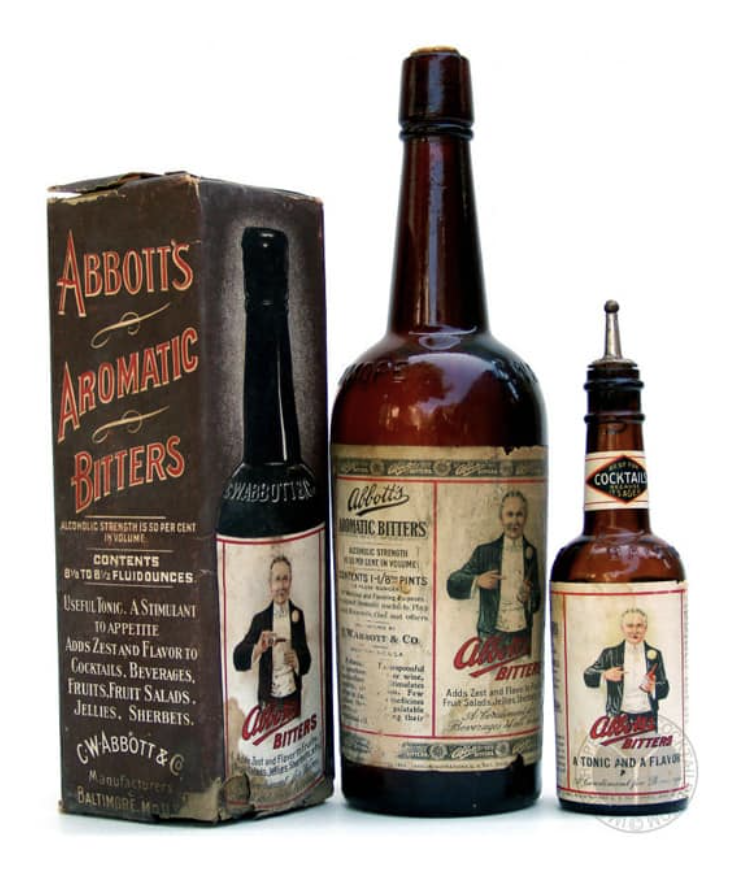A Bitter History
In 1803, The Farmer’s Cabinet periodical identified a combination of “sugar, water, spirits, and bitters” and referred to it as a “cocktail”. How did this ancient form of medicine make it to the liquor cabinets of the American colonies?
Herbal bitters have a long and storied history, but our familiarity harkens back to their role as patented medicines. Your grandparents were probably adding Abbotts Bitters to their evening cocktail, but really this whole concept developed as a way to make the medicine go down a little more easily. Actually, the history of bitters takes a little more nefarious of a turn the further back you go. The earliest documented origins of bitter concoctions being intentionally formulated was as early as 100 BC in Asia Minor for the express purpose of avoiding poisoning by one’s enemies. The blend would essentially speed up how quickly the body was able to expel toxins, which in turn sped up metabolism.
The bitter flavor comes from plant constituents like flavonoids, berberine, lacupicrine, and tannins in the roots and leaves. They function to protect the plant from UV light, and serve as structural supports, but they also deter herbivores and omnivores from wiping them out. As time progressed and the plants evolved, the interaction between plant/mammal began to change, ending in an interaction that allowed the plant’s nutrients and bitter properties to increase the digestive fluids of the consumer. Some of these plants retained enough of the toxins to pose a significant risk, but others developed just enough of a stimulating action without being too irritating. This is also why it is so important to identify plants appropriately- belladonna and water hemlock being an example.
Bitters hold just as much relevance in our modern health as they have in our history. Our culture has a significant ‘bitters deficit’- this can show up as congested liver contributing to blood sugar imbalances, heart inflammation, and fatty deposits in the liver. Re-introducing these in a health context also provides necessary vitamins, minerals in addition to improving both upper and lower digestion, detoxification, and elimination.
How? When your taste buds detect the characteristic bitterness, they send a message to the vagus nerve, warning of a possible toxin exposure. This sounds the alarm in the gut and increases the flow of acids in the stomach, breaking down proteins & extracting nutrients from your food. Then the liver and gallbladder increase the bile released into the lower digestive tract to break down the fats and oils in your food. These two stay on high alert tackling the caloric load and stabilizing blood glucose levels, while also working to purify the blood (hence the ‘alterative’ label). Then the colon responds and produces more regular bowel movements to evacuate the perceived ‘toxins’ out of the system. This is how bitters works in a synergistic method to produce better digestion and elimination.
Bitters can help improve blood purification (alterative), constipation, gas, bloating, overeating, poor appetite, nausea, poor digestion of fats, some food intolerances, and helping the body repair gut wall damage- this list gives you a good idea of why bitters have such staying power! For more information, visit our Instagram page to learn more about who should (and shouldn’t!) be using bitters, and some great ways to start your own batch!
- Who SHOUDN’T use bitters? Pregnant, kidney stones, gallbladder disease, dysmenorrhea, GERD, hiatal hernia, gastritis, peptic ulcers. ALWAYS work with a qualified practitioner when implementing herbs.
- What plants are good for bitters? Dandelion is probably most popular. Yellow burdock, ginger, barberry, burdock.


